ABSTRACT
BACKGROUND AND AIM
Autism Spectrum Disorder is a developmental and neurological disorder that affects communication, behavior, social skills, and pragmatics. Over time, multiple pieces of research have been performed to evaluate the etiology and intervention of this disorder. One such approach includes ‘The Nemechek Protocol’. The survey-based study conducted on “How Fruitful is The Nemechek Protocol for Children with Autism Spectrum Disorder”, aims to assess the efficacy of the protocol for reversal of Autism. This approach purports to ‘repair’ the autonomic functioning of the brain, ‘reverses’ Autonomic Dysfunction by treating intestinal bacterial overgrowths, ‘restores’ microglia function, and ‘maintain’ continued cellular and organ repair.
METHODOLOGY
Survey-based research was conducted. The participants were recruited using simple random sampling. A self-administered questionnaire was presented to the sample, and subsequent questions were asked.
RESULTS
A total of 304 participants completed the questionnaire. Out of which, 256 fell within the inclusion criteria. The results exhibited that 193 participants reported speech development. Moreover, 247 parents also chose to recommend the protocol.
CONCLUSION
It was concluded that out of 256 participants, 200 demonstrated a positive change. The areas of development included speech and language development, increased awareness of the surroundings, and a decline in stimming. 16 participants revealed regression. For these, analysis was performed to infer the reasons. And 40 participants in the sample stated both, presence of progression and regression.
KEYWORDS
Autism Spectrum Disorder, Communication, The Nemechek Protocol, Autonomic Dysfunction, Bacterial Overgrowth, Neurodevelopmental Disorders
Ameerah Ganny
Student
College of Speech Language and Hearing Sciences, Ziauddin University
ORCID ID: 0000-0002-0908-3370
Inaara Rahim Somani
Student
College of Speech Language and Hearing Sciences, Ziauddin University
ORCID ID: 0000-0002-6702-4002
Kiran Ali Khan
Student
College of Speech Language and Hearing Sciences, Ziauddin University
ORCID ID: 0000-0003-2211-6306
Anusha Abdul Ali
Student
College of Speech Language and Hearing Sciences, Ziauddin University
ORCID ID: 0000-0002-6702-4002
Fatima Yousuf
Senior Lecturer and Speech Language Therapist
College of Speech Language and Hearing Sciences, Ziauddin University
ORCID ID: 0000-0002-3237-1290
[Ganny A, Somani IR, Khan KA, et al. Miracles Do Happen- How Fruitful Is the Nemechek Protocol For Children with Autism Spectrum Disorder?
Pak.j.rehabil. 2022; 11(1):107-117]
DOI: 10.36283/pjr.zu.11.1/014
INTRODUCTION
The word ‘Autism’ is derived from the word autos belonging to the Greek origin which means self. The term autism and autistic were coined by a psychiatrist named Eugen Bleuler in 1911. Previously, the term autistic was used to describe a characteristic of schizophrenia where an individual withdraws from the outside world and gets immersed into a realm of his own. As time progressed and under the light of countless researches, in 1943, Leo Kanner cleared the misconceptions and defined the characteristics of autism that are still relevant in recent times. It is swiftly becoming one of the most prevalent disorders among children nowadays1. It is reported to be present in individuals of all ethnic, racial, and socio-economic backgrounds. It is found to be more common in boys than girls for reasons unknown. Autism Spectrum Disorder refers to a broad range of conditions characterized by challenges with restricted and repetitive behaviors2,3, pragmatics4,5, social skills, speech, and linguistic skills. Several factors contribute to influencing the development of Autism. And it is often accompanied by medical issues, such as gastrointestinal disorders, seizures or sleep disorders, and sensory sensitivities6, as well as mental health challenges such as attention disorders7,8, anxiety9,10, and depression11. Over the years, autism has become one of the most researched phenomena. The researchers have published numerous researches outlining the minute details which make this phenomenon exceptional and unique in the pool of disorders. The recent research has defined two subtypes of autism; early-onset12 and regressive. The early onset is when the child demonstrates signs of autism at the early age of twelve months. For instance, lack of babble and joint attention whereas regressive autism is when the child demonstrates typical achievement of milestones for a while but then starts to regress as autism progresses. Furthermore, the researchers have identified the three core features that bind the autism spectrum disorder together. These three features form the basis of the diagnostic criteria for autism spectrum disorder. The first core feature identified is the inability to reciprocate social interaction. Children with autism or autism spectrum disorder face immense difficulty in maintaining social interactions, especially among peers. These children are perceived to have a lack of social interest but, contrastingly, they cannot mingle with peers and make social connections. The second feature focuses on the significance of communication13. It is communication that enables the transmission and reception of messages. Children with autism or ASD are said to have severe communication deficits, their inability to indulge in two-way communication makes their interactions limited. The third and the last feature is about their restricted interests and repetitive activities. These children prefer to have monotony in their lives. It is the possessiveness associated with the interests and a strong aversion to change, that makes them exclusive among fellow children. Regardless of the extensive researches conducted, no known cause or cure has been found to date; however, early identification supplemented with early intervention has proven to benefit individuals with autism or autism spectrum disorder.
There has been a considerable amount of exploration conducted by researchers to facilitate individuals with autism, one of the many names is Dr. Patrick Nemechek. He graduated from San Diego University (1982) with a B.S. in Microbiology and obtained his Doctorate from the University of Health Sciences in Osteopathic Medicine (1987). Dr. Nemechek undertook his research and training for the autonomic nervous system disorders at Universidade De Lisboa, Lisbon. He discovered during his training the key to treat and reverse several conditions and disorders that people suffer through using the three-part approach:
- Renewal of stem-cell production14
- Reversal of Autonomic System Dysfunction15
- Re-establishment of neurogenesis
To treat or reverse the conditions, Dr. Nemechek came with ‘The Nemechek Protocol’ that brings balance to children’s or adult bodies by making a few additions to their diet. The three components that are part of the protocol are Fish Oil, Inulin16, and Extra Virgin Olive Oil.
Inulin17 tends to increase the acidity of the small intestine, through repression of the growth of the unwanted bacteria in the small intestine. On the other hand, Inulin18 fiber encourages the growth of healthy bacteria19. Fish Oil20 serves as a suppressant to the dysfunctional microglia21, and combined with the reduction of omega-6 oils in the diet can result in a cytokine reduction, which lowers the inflammation22, 23. Extra Virgin Olive Oil contains 70% oleic acid, which tends to upend and reverse underlying inflammation that results from too much omega-6 and palmitic acid.
Dr. Nemechek in his book ‘Miracles Do Happen’ states that once the bacterial overgrowth is reversed and propionic acid levels decline24, the child is supposed to reach ‘the awakening period’. During this period the child may demonstrate either positive or negative behaviors. The child may become more observant and aware of the environment or he may become more aggressive and anxious. The negative behavior does not indicate the worsening of their autism instead; this is a child who is now fully alert without the sedating effects of propionic acid25, 26.
The only way to gather data regarding the fruitfulness of the protocol was to conduct a survey so – How Fruitful is The Nemechek Protocol for Children with Autism Spectrum Disorder was conducted.
METHODOLOGY
Research design is a framework of methods chosen by the researcher, intending to combine components of research logically so that the research problem is efficiently handled. The type of research design chosen and conducted by our group was survey-based research. Survey methodology includes procedures whereby a questionnaire is created to gather data from the sample population. The three main survey research methods include; online or e-mail, phone, and face to face. Each method has a distinct style of administration. Our group opted for the online survey method which incurred minimal costs and yielded accurate and authentic data.
To conduct the research, a questionnaire was published on different social media outlets. The research design for our survey is mixed, catering to both components, qualitative and quantitative data. Being quantitative, it will yield results that are discrete and conclusive, providing data in table form. For example, ‘Has your child reached the awakening period?” such questions have options provided and will give conclusive data. On the other hand, it also contains qualitative questions that aim to describe the situation; hence, being exploratory. For example, questions like “Please describe your child’s progression or regression after the use of Nemechek Protocol”. The qualitative questions were provided with a specified word limit for the respondents, in order, to avoid extremely lengthy answers and redundant data which would prove to be difficult in terms of analyzing and filtering information as well as drawing conclusions.
The data was gathered through a structured questionnaire. The consent was sought from the subject before participation. This was done by presenting a cover letter formed through institutional consent. The questionnaire built required approximately 10 minutes to complete, comprising of twenty-seven questions. After all the questionnaires were filled, the data was interpreted and results were obtained.
SAMPLING
The participants for the research were selected through probability sampling. This sampling technique selects the participants from a bigger population. Out of the four types of probability sampling, our survey has used simple random sampling. This technique provides every individual with a fair chance of being selected; therefore, reducing the sampling bias to a minimum. The target population was not standardized according to geographical location, caste, or racial barriers. The respondents of the study included parents of children with autism spectrum disorder from around the world that are implementing The Nemechek Protocol on their children. The sample size included three hundred and four participants, out of which two hundred and fifty-six were chosen to be valid.
QUESTIONNAIRE
The questionnaire comprised of twenty-seven questions with a variety of open-ended, close-ended, and contingency questions. The questions constructed were simple, short, and to the point. The answers were chosen from a pool of obtainable options but provided the participant with the liberty to specify another response if any. The questionnaire also provided an opportunity for the participant to clarify their evaluations regarding The Nemechek Protocol in detail. Moreover, the questions asked were unbiased and did not lead the participant, concerning the protocol.
The questionnaire included demographic questions such as, “What is the age of your child?”, and “What is the gender of your child?”. Then it progressed towards inquiring about the diagnosis and duration since when the protocol has been followed. To have a deep insight into the communicative skills of the child, including speech and language, subsequent questions were asked. These included, “How does your child best communicate with others?” and the choices provided were “spoken language, written language, sign language, Augmentative and Alternative Communication (AAC)”
As the protocol includes usage of Extra Virgin Olive Oil (EVOO), prebiotic fiber Inulin, DHA (docosahexaenoic acid), and EPA (eicosapentaenoic acid) Omega-3 fatty acid supplementation from fish oil; therefore, participants were inquired upon its dosage and uses. For example, the questions included were, “What dosage of EPA+DHA Omega-3 (Fish Oil) does your child take?” and “What dosage of Extra Virgin Olive Oil (EVOO) does your child take?”. All such questions included options for the participants to choose from.
It was vital to assess the co-morbidities of the individual; henceforth, corresponding questions were also included. For example, “before starting Protocol, did your child have any of the following concerns?” The options included, “sensitivity (hypersensitivity/hyposensitivity), allergies, seizures, Autonomic Dysfunction (high blood pressure, insomnia, dizziness, and anxiety)”. To look into other factors that may impact the intervention process and progress, relevant questions were included. For example, “Is your child enrolled in any of the following program/programs?” And therefore the answer options were the subsequent, “Vagus Nerve Stimulation (VNS), Pivotal Response Therapy, Applied Behavior Analysis, Verbal Behavior Therapy, Sensory Integration Therapy, Speech, and Language Therapy”.
In the end, qualitative questions were inquired to assess the progress and betterment of the individual. Questions included, “do you think the Nemechek Protocol has benefitted your child in any way?”, “would you recommend the Nemechek Protocol to other people?”, “Please describe your child’s progression or regression after the use of the Nemechek Protocol”.
ETHICAL CONCERNS
While conducting the study, ethical considerations and principles were highlighted. To begin with, researchers collected informed consent from the sample. The sample was informed about the purpose of the study and presented with a cover letter including all the details, approved by the institute. The cover letter stated: “There is no compensation for responding nor is there any known risk. The data collected will provide us useful information regarding the Nemechek Protocol and its efficacy. Rest assured that all the data gathered will be treated with the utmost confidentiality and will be used for academic purposes only”. The participants were not harmed during the study by any means. Moreover, the research aimed to protect the anonymity and confidentiality of the participants. The research participants had the right to withdraw from the process at any point and were made aware of this from the start.
RESULTS
The sample size of the research constituted two hundred and fifty-six (256) participants. Initially, three hundred and four (304) filled the questionnaire. Forty-eight (48) of these did not have a diagnosis for Autism Spectrum Disorder; therefore, they were not included in the data analysis.
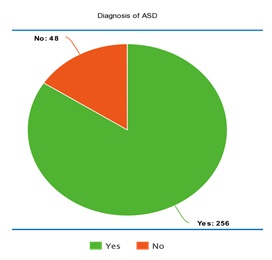
These children; however, had other neurodevelopmental or genetic disorders but did not meet the demands for inclusion criteria. The sample consisted of two hundred and forty-two (242) infants and children, eleven (11) teenagers, and three (3) adults who were following this protocol.
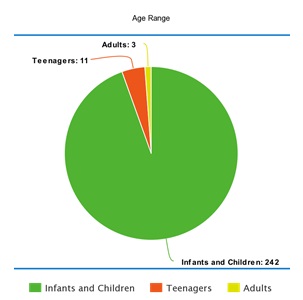
It consisted of two hundred and seven (207) male participants and forty-nine (49) female participants. The reported time range of following this protocol was from 15 days up to 3 years.
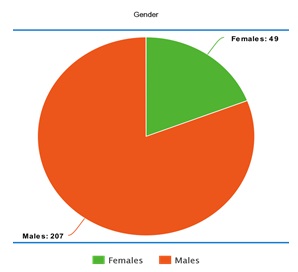
The participants were questioned about their knowledge of The Nemechek Protocol. Upon analyzing the result, it was reported that from the total two hundred and fifty-six (256) participants, ninety-seven (97) became acquainted with The Nemechek Protocol from the parents of other children with autism. Whereas one hundred and forty-seven (147) discovered it online through social media platforms like Facebook and Instagram. And the remaining twelve (12) marked other sources.
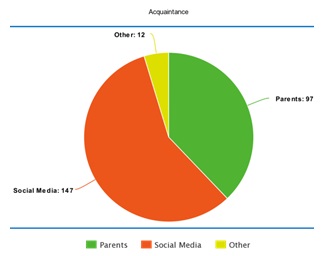
Participants were inquired to evaluate the status of their communicative status and abilities. Parents reported that their child best communicated with others using the following modalities: one hundred and thirty-seven (137) children communicate with spoken language, fifty-seven (57) with sign language, sixty (60) with Augmentative and Alternative Communication (AAC), and two (2) with the use of written language.
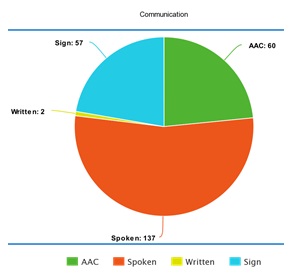
It was observed that before commencing the protocol, seventy-six (76) children had no comorbid concerns or conditions. However, a total of one hundred and eighty (180) had some comorbidities. These included sensitivity, seizures, insomnia, allergies, etc.
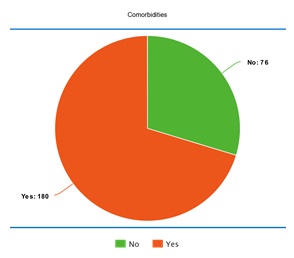
Participants were also asked about their child’s enrollment into other intervention programs to evaluate its influence on the child. Alongside using the protocol, two hundred and sixteen (216) children were also enrolled in other programs. These programs included Applied Behavior Analysis, Vagus Nerve Stimulation, Speech and Language Therapy, Verbal Behavior Therapy, Sensory Integration Therapy, and Pivotal Response Therapy.
The sample also consisted of participants who presented with dosage errors. These included sixteen (16) participants with dosage errors for Inulin, three (3) for EVOO, and thirty-nine (39) for fish oil. Two hundred and twelve (212) responses reported that their child had reached the awakening period; while, forty-four (44) reported no such symptoms observed in their child In terms of speech and language development in their children, the following data was yielded. Results showed that before using the protocol, one hundred and four (104) children were verbal; while, one hundred and fifty-two (152) were non-verbal. From a total of two hundred and fifty-six (256), one hundred and ninety-three (193) reported speech development in their children after following the protocol.
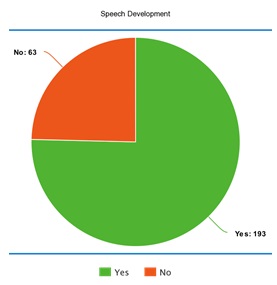
Out of (256) two hundred and fifty-six participants, (241) reported that the protocol was beneficial to their child. Furthermore, (247) two hundred and forty-seven also chose to recommend it to other parents.
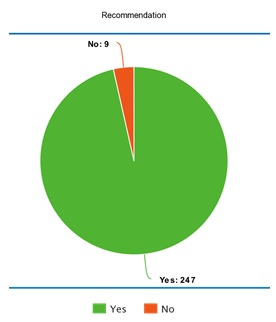
CORRELATION OF RESULTS
The results of the survey-based research may be correlated with ‘Autism Spectrum Disorder Symptoms Improve with Combination Therapy Directed at Improving Gut Microbiota and Reducing Inflammation (Nemechek; 2020)’27. Analysis of both the research reveals that progression and regression are present after using the protocol. The methodologies of both the research differ. The correlated research was based upon structured observations and parental reports. However, both of these share the common aim of collecting relevant data for the efficacy of the protocol. Furthermore, interrelation is observed as both aim to analyze the reversal of autonomic dysfunction and bacterial overgrowth.
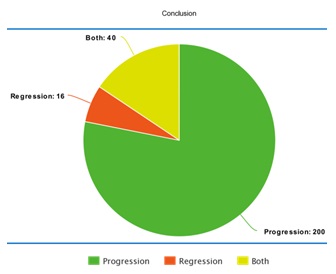
CONCLUSION
The survey-based research performed on “How Fruitful is The Nemechek Protocol for Children with Autism Spectrum Disorder?” was conducted to explore the effects of protocol on individuals with Autism Spectrum Disorder. Upon analyzing the results obtained, it was determined that out of two hundred and fifty-six (256) participants, two hundred (200) of them demonstrated a positive change. The main area of development included speech and language development. As for an individual with Autism Spectrum Disorder, their speech and language skills are highly affected. Not only do they face problems in communication, but their ability to infer social and non-verbal cues is also affected.
Other positive changes revealed in individuals included an increased awareness of the surrounding, a decline in stimming behaviors, maintenance of eye contact, lexical expansion, and reduced sensory seeking behaviors. A few of the positive responses reported by the parents were that their children were able to “accept food textures”, demonstrated “improvement in play skills”, “imitation skills improved”, and, “able to follow commands”.
On the other hand, sixteen (16) participants revealed regression after the use of the protocol. Upon examining the reasons, it may be inferred that this took place due to dosage errors, not following the protocol for enough duration to see positive effects, or the child might be in the awakening period. Few of the responses of parents of these children included, “an increase in negative outbursts”, “constipation”, and “an increase in hyperactivity”.
Forty (40) participants in the sample stated both, presence of progression and regression observed by them in their child. For example, a drastic improvement in expressive and receptive language, and regression through an increase in vocal stimming.
REFERENCES
- Baio J, Wiggins L, Christensen DL. Prevalence of Autism Spectrum Disorder Among Children Aged 8 Years — Autism and Developmental Disabilities Monitoring Network, 11 Sites, United States, 2014. MMWR SurveillSumm. 2018;67(No. SS-6):1–23
- Berry K, Russell K, Frost K. Restricted and repetitive behaviors in autism spectrum disorder: A review of associated features and presentation across clinical populations. Current Developmental Disorders Reports. 2018 Jun;5(2):108-15.
- Lin CE, Koegel R. Treatment for higher-order restricted repetitive behaviors (H-RRB) in children with autism Spectrum disorder. Journal of autism and developmental disorders. 2018 Nov;48(11):3831-45.
- Cardillo R, Mammarella IC, Demurie E, Giofrè D, Roeyers H. Pragmatic Language in Children and Adolescents With Autism Spectrum Disorder: Do Theory of Mind and Executive Functions Have a Mediating Role?. Autism Research. 2021 May;14(5):932-45.
- Andrés-Roqueta C, Katsos N. The contribution of grammar, vocabulary and theory of mind in pragmatic language competence in children with autistic spectrum disorders. Frontiers in psychology. 2017 Jun 15;8:996.
- Thye MD, Bednarz HM, Herringshaw AJ, Sartin EB, Kana RK. The impact of atypical sensory processing on social impairments in autism spectrum disorder. Developmental cognitive neuroscience. 2018 Jan 1;29:151-67.
- Vivanti G, Fanning PA, Hocking DR, Sievers S, Dissanayake C. Social attention, joint attention and sustained attention in autismSpectrum disorder and Williams syndrome: convergences and divergences. Journal of autism and developmental disorders. 2017 Jun;47(6):1866-77.
- Dougherty CC, Evans DW, Myers SM, Moore GJ, Michael AM. A comparison of structural brain imaging findings in autism spectrum disorder and attention-deficit hyperactivity disorder. Neuropsychology review. 2016 Mar 1;26(1):25-43.
- South M, Rodgers J. Sensory, emotional and cognitive contributions to anxiety in autism spectrum disorders. Frontiers in human neuroscience. 2017 Jan 24;11:20
- Kirsch AC, Huebner AR, Mehta SQ, Howie FR, Weaver AL, Myers SM, Voigt RG, Katusic SK. Association of comorbid mood and anxiety disorders with autism spectrum disorder. JAMA pediatrics. 2020 Jan 1;174(1):63-70.
- DeFilippis M. Depression in children and adolescents with autism spectrum disorder. Children. 2018 Sep;5(9):112
- Ozonoff S, Iosif AM. Changing conceptualizations of regression: What prospective studies reveal about the onset of autism spectrum disorder. Neuroscience & Biobehavioral Reviews. 2019 May 1;100:296-304.
- Mandy W, Wang A, Lee I, Skuse D. Evaluating social (pragmatic) communication disorder. Journal of Child Psychology and Psychiatry. 2017 Oct;58(10):1166-75.
- Siniscalco D, Kannan S, Semprún-Hernández N, Eshraghi AA, Brigida AL, Antonucci N. Stem cell therapy in autism: recent insights. Stem Cells Cloning. 2018;11((55-67)
- Filcikova D, Mravec B. Alterations in autonomic nervous system in autism spectrum disorders: Means of detection and intervention. Act. Nerv. Super. Rediviva. 2016 Jan 1;58:115-7
- Abdelhameed A, Alqaysi RH, Alharbi N. Study the Gastrointestinal Flora in Autism Spectrum Disorders (ASDs): Mini Review. Journal of Global Scientific Research (ISSN: 2523-9376). 2020;11:895-901.
- Chong CY, Orr D, Plank LD, Vatanen T, O’Sullivan JM, Murphy R. Randomised double-blind placebo-controlled trial of inulin with metronidazole in non-alcoholic fatty liver disease (NAFLD). Nutrients. 2020 Apr;12(4):937.
- Teferra TF. Possible actions of inulin as prebiotic polysaccharide: A review. Food Frontiers. 2021.
- Fayed B, El-Sayed HS, Abood A, Hashem AM, Mehanna NS. The application of multi-particulate microcapsule containing probiotic bacteria and inulin nanoparticles in enhancing the probiotic survivability in yoghurt. Biocatalysis and Agricultural Biotechnology. 2019 Nov 1;22:101391.
- Jović M, Lončarević-Vasiljković N, Ivković S, Dinić J, Milanović D, Zlokovic B, Kanazir S. Short-term fish oil supplementation applied in presymptomatic stage of Alzheimer’s disease enhances microglial/macrophage barrier and prevents neuritic dystrophy in parietal cortex of 5xFAD mouse model. Plos one. 2019 May 16;14(5):e0216726.
- Jović M, Lončarević-Vasiljković N, Ivković S, Dinić J, Milanović D, Zlokovic B, Kanazir S. Short-term fish oil supplementation applied in presymptomatic stage of Alzheimer’s disease enhances microglial/macrophage barrier and prevents neuritic dystrophy in parietal cortex of 5xFAD mouse model. Plos one. 2019 May 16;14(5):e0216726.
- Huber LA, Hooda S, Fisher-Heffernan RE, Karrow NA, de Lange CF. Effect of reducing the ratio of omega-6-to-omega-3 fatty acids in diets of low protein quality on nursery pig growth performance and immune response. Journal of animal science. 2018 Sep 29;96(10):4348-59.
- DiNicolantonio JJ, O’Keefe JH. Importance of maintaining a low omega–6/omega–3 ratio for reducing inflammation. Open heart. 2018 Nov 1;5(2):e000946.
- Dryahina K, Smith D, Bortlík M, Machková N, Lukáš M, Španěl P. Pentane and other volatile organic compounds, including carboxylic acids, in the exhaled breath of patients with Crohn’s disease and ulcerative colitis. Journal of breath research. 2017 Nov 28;12(1):016002.
- Nemechek DPM, Nemechek JR. Miracles Do Happen. Vol. 1.United States: Autonomic Recovery, LLC.; 2017.
- Abdelli LS, Samsam A, Naser SA. Propionic Acid Induces Gliosis and Neuro-inflammation through Modulation of PTEN/AKT Pathway in Autism Spectrum Disorder. Sci Rep.
- Nemechek P, Moore A. Autism Spectrum Disorder Symptoms Improve with Combination Therapy Directed at Improving Gut Microbiota and Reducing Inflammation. Appl Psychiatry. 2020 Jul; 1(1).
